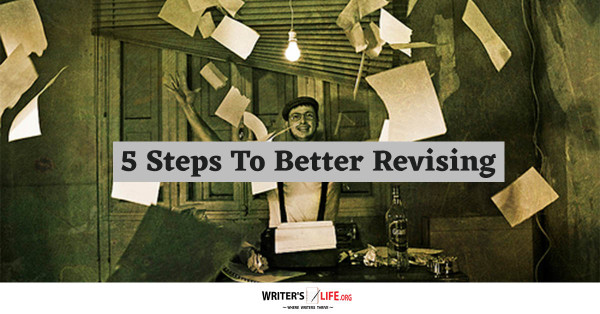- How To Tackle Jealousy In Creative Writing
- Common Submission Mistakes
- How To Stop Your Blog Becoming Boring
- The One Thing Every Successful Writer Has In Common
- How To Make Yourself Aware Of Publishing Scams
- Why Almost ALL Writers Make These Grammar Mistakes At Some Point
- 5 Tips For Authors On How To Deal With Rejection
- Top Mistakes to Avoid When Writing a Novel
- How to Avoid Common New Writer Mistakes
- 10 Mistakes New Fiction Writers Make
5 Steps To Better Revising

Hello, and welcome back to Writer’s Life! Today, I’d like to give you 5 steps to better revising. For many of us, the joy of writing is in the creation, being surprised by our character’s actions and reactions, and exploring the worlds our characters inhabit. Once you have written the story down, the real work of writing begins: revising it, polishing it, turning it from an uncut lattice arrangement of carbon atoms into a shining diamond. Revising is work, and for many writers it is not nearly as much fun as writing itself, so here are some tips that you may find eases the burden, at least a little.
Begin at the Beginning
Start revising by going from the beginning to the end. Print your project out on paper, take it and a pen or pencil with you to a favorite reading spot with a favorite reading beverage, and read it. Read it like it’s a new book. When reading it, ask yourself if things work, if they make sense, and mark anything that is cliché, trite, or out of place.
Consider using an Automated Tool
There are several automated options that will help you identify possible errors, overused or improperly used words, or grammar mistakes. We all make them, and having an automation tool look over the work will often flag things we didn’t even think about. There are a host of Visual Basic macros for Word that will do this—just be careful if you download VB macros as they are a significant vector for computer viruses, so vet your sources carefully—and at least one other tool, Hemingway App (free online, $10 to download to your PC or Mac). Hemingway, in particular, is a good first-pass tool to identify sentences that are hard to read, use adverbs, or are written in the passive voice.
Watch your (Passive) Voice
Speaking of the passive voice, watch it … that is, watch out for it, and mark those passages for later revision. As writers, we hear it repeated often that passive voice is bad. Overuse of the passive can make for a document that is tough to read. More to the point, the passive voice often confuses the reader about who does what, making it hard to follow the flow of action. While you should definitely look for uses of the passive voice sometimes it’s perfectly reasonable. Using an automated tool can highlight uses of the passive voice in your project, making them much easier to find.
Have I tied up loose ends?
While reading your printed work, make notes to yourself about the plot, and any sub-plots that come up. Ask yourself, when you’ve finished, if you've resolved those plots and sub-plots, and if not what you might do to resolve them. There should be an explicit outcome for your characters, even minor ones. Any object mentioned specifically should be there for a reason, even if the reason is mundane.
Stop when it’s Done
Sometimes, it can be difficult to know when you’re finished revising. We all have our doubts about our own writing, it’s inherent in the business of being creative. Knowing when a project is “done” can be hard to pinpoint, but here’s a general rule of thumb: if you are going over it and making small changes only every few dozen pages to your phrasing or word choices, it’s done. Typos, punctuation errors, those are not “revising” but rather error-correcting. That should continue and if you find more than a few, I recommend having a proofreader take another look at it, with different eyes. But you can stop revising when you aren’t making changes to the plot, the characters, or the overall arc of your project.
In Conclusion
With these 5 steps to better revising, I hope I’ve given you some tools you can use to start your own revision process, or revisit it if needed. As always, leave comments or questions below, and happy writing!


























